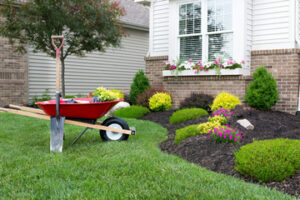Landscaping enhances the beauty of your property and increases its value. It also creates a healthy environment for native plants and wildlife and benefits your family’s health and well-being.

Start by listing your goals and needs. You may want a lawn for kids and dogs, or perhaps a flower garden with colorful shrubs. Visit https://www.ecograssnwa.com/ to learn more.
The design of plants is a key aspect of landscaping. It involves the use of flowers, trees, and shrubs to create a pleasing visual environment. It also involves arranging these elements in ways that are functional and complement the surrounding environment. Landscaping requires an understanding of horticultural practices and the ability to envision how different plants will grow together in a garden. Landscaping professionals must also be able to select and install the right plants for a particular climate and soil conditions.
A commercial landscape requires a mix of beautiful and functional plants to enhance the beauty of your property. A well-planned commercial landscape will include a variety of colors and textures to complement the architecture of your building and attract customers to your business.
When selecting your plants, consider how much maintenance each will require. Annual plants typically have one growing season, while bi-annual plants live for two years. Perennials and shrubs may be a better choice for your location, as they typically live longer and will provide color throughout the year. Using native plants is often a good choice, as they are adapted to the local conditions and can help preserve water and soil quality.
In addition to plants, a landscape includes other non-living elements such as walkways, patios, and outdoor living spaces. Landscapers can also construct and maintain structures like fences, driveways, decks, pools, and retaining walls to improve the functionality of an outdoor space. In addition to these structural enhancements, commercial landscaping services include pest control and pruning. This is necessary to protect the health and safety of your employees and customers while enhancing the overall appeal of your business.
Hardscapes
While plants are certainly a necessary component to a beautiful landscape, hardscapes are just as important. Using a variety of man-made materials, hardscapes create walkways and outdoor living areas to increase the functionality of your property. Hardscapes can also help to define spaces and add visual appeal, creating unique textures that complement your plant selections.
Hardscapes include elements like paving stones, rock, brick and concrete. These materials are often used to create pathways, retaining walls and garden beds. They can also be stained, stamped or embedded with other materials to create a more interesting look. Whether you’re looking for a simple paver patio or a more elaborate water feature, a professional can help to plan and execute the perfect hardscape design for your home.
One of the most important aspects of hardscape design is determining how you want to use your space. Do you want a large patio where you can entertain guests? Perhaps you’d prefer a fire pit for cozy evenings outdoors. Hardscapes can also increase the usability of your yard, with features such as patios, seating areas and outdoor kitchens making it possible to enjoy your yard even in the winter.
Another important aspect of hardscape design is choosing the right materials. Different materials offer a range of benefits, from cost to durability. Some materials, such as sandstone and granite, offer natural color and texture that complement the rest of the landscape. Other materials, such as brick and concrete, are more durable and can withstand heavy traffic and weather conditions.
A well-designed hardscape can also be more sustainable than a traditional garden, with features such as permeable surfaces and rain gardens helping to reduce the amount of water that needs to be irrigated. In addition, hardscapes can help to minimize the need for maintenance tasks such as mowing and watering, increasing your time to enjoy your landscape.
Lighting
Landscape lighting is a crucial element that allows you to enjoy your outdoor spaces after dark. It can highlight architectural features and accentuate plants and trees in your yard to create a beautiful, welcoming atmosphere. It also improves safety by illuminating walkways, preventing guests from tripping or falling and deterring intruders.
The right lighting can create a variety of moods in your outdoor space, from warm and inviting to bold and dramatic. Depending on fixture placement, color temperature, and focus, lighting can reveal texture and definition of your garden and patio areas. The right combination of lighting can give your yard a unified, balanced look that makes it stand out from the rest.
Properly placed lighting can make your home and property visible after the sun goes down, creating a sense of security and well-being for you and your family. It can also extend the usability of your outdoor spaces, allowing you to enjoy your yard and patio for entertaining or relaxing long after the sun sets.
There are many different types of landscape lighting, including path lights, spotlights, and downlights. Each type of light serves a different purpose. Path lights illuminate walkways, while spotlights emphasize architectural features or plants. Downlights cast light downward, resembling moonlight, and can be used to highlight water features or a statue. By combining different types of landscape lighting, you can achieve a layered effect that highlights your yard’s most important features and creates an inviting atmosphere for your friends and family. This can increase your property value and help you stand out from the competition, making your home more desirable in the real estate market. It can also elevate your curb appeal, giving your home a dramatic, luxurious appearance that stands out from the rest.
Irrigation
An essential component of landscaping is the irrigation system, which nurtures newly installed landscapes and maintains their beauty and health. This includes ensuring that all areas receive the right amount of water based on type and soil conditions.
A well-designed irrigation system consists of pipes, valves, sprinklers, and meters that work together to achieve optimal water distribution. It can reduce water waste through sensors and smart controllers that monitor weather and soil conditions to adjust the amount of watering needed for every zone. It also allows for easy monitoring from anywhere, even if you are away from home.
Landscaping is the art of designing, modifying, and maintaining outdoor spaces by adding plants or altering terrain to create a visually appealing environment. It can also involve the use of water, fire, lighting, and ornamental features to enhance a space. It is the combination of these elements that elevates a garden or yard from ordinary to extraordinary.
In addition to aesthetics, landscaping provides many practical benefits, including raising property values, improving security, reducing energy costs, and creating habitats for wildlife. However, it takes time and effort to maintain a lush, beautiful landscape. Many homeowners are now seeking ways to enjoy the benefits of landscaping without the associated labor.
One way to do this is by installing an efficient, low-maintenance landscaping system. This can help eliminate the need for manual mowing and weeding, while still providing the lush, green yard that everyone wants. However, it is important to remember that not all systems are created equal. A poorly-designed or faulty irrigation system may not only cause damage to your landscaping, but it can also lead to expensive repairs and high water bills.
Maintenance
It’s common to think of landscaping as a one-time investment, but the truth is that landscape design requires a consistent maintenance program to reach its full potential. The longer that you let your property go without regular care, the more work it will need to return to a healthy state.
In addition to reducing curb appeal, an unkempt garden can also harm the health of your plants. For example, uncontrolled weeds compete with your plants for water, nutrients and sunlight. Over time, this can weaken and even kill them.
On the other hand, a well-maintained landscape promotes healthy growth, prevents pest infestations and adds to the visual appeal of your home or business. However, it’s easy to get overwhelmed by the sheer amount of lawn and garden work that needs to be done. This is where hiring professional landscape services becomes an invaluable investment.
Landscaping services can help you realize your creative vision for your outdoor space, and they can then take over the work so that it’s always done right and on schedule. They can also provide expert advice about which plants, trees and bushes will thrive in your area’s climate, and they can help you to build an efficient irrigation system that minimizes water wastage.


